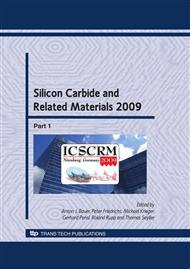p.347
p.351
p.355
p.359
p.363
p.367
p.371
p.375
p.379
Stacking Faults around the Hetero-Interface Induced by 6H-SiC Polytype Transformation on 3C-SiC with Solution Growth
Abstract:
6H-SiC hetero-epitaxially grown on a (111) 3C-SiC was observed with TEM. High-density stacking faults were formed around the hetero-interface, and the density of stacking faults decreased with increasing distance from interface. On the other hand, when 3C-SiC was homo-epitaxially grown on a 3C-SiC, any stacking faults did not exist at the interface between the grown crystal and the seed crystal. Thus, the stacking faults formation started from the 6H/3C hetero-interface. Considering the lattice-mismatch strain between 3C-SiC and 6H-SiC, the strain energy is equivalent to the stacking fault energy of 6H-SiC. This similarity suggests that the stacking faults formation could be caused by the relaxation of the lattice-mismatch strain.
Info:
Periodical:
Pages:
363-366
Citation:
Online since:
April 2010
Price:
Сopyright:
© 2010 Trans Tech Publications Ltd. All Rights Reserved
Share:
Citation:


